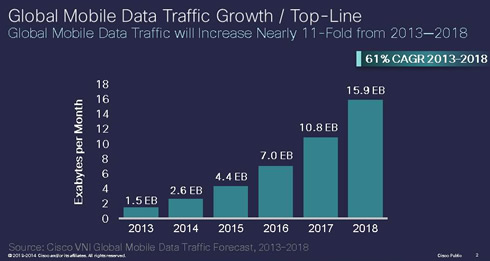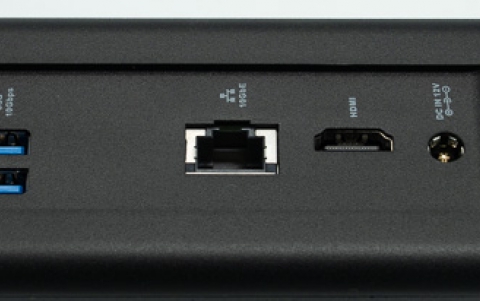
Cisco Forecast Nearly 11-Fold Increase in Global Mobile Data Traffic from 2013 to 2018
Worldwide mobile data traffic will increase nearly 11-fold over the next four years and reach an annual run rate of 190 exabytes (4 trillion video clips e.g., YouTube) by 2018, according to a report released on Wednesday.
The projected increase in mobile traffic is partly due to continued strong growth in the number of mobile Internet connections, such as personal devices and machine-to-machine (M2M) connections, which will exceed 10 billion by 2018 and be 1.4 times greater than the world's population (the United Nations estimates 7.6 billion people by 2018), a forecast by Cisco Systems Inc. says.

Cisco says the incremental amount of traffic being added to the mobile Internet just between 2017 and 2018 is 5.1 exabytes per month, which is more than three times the estimated size of the entire mobile Internet in 2013 (1.5 exabytes per month).
From 2013 to 2018, Cisco anticipates that global mobile traffic growth will outpace global fixed traffic growth by a factor of three. By 2018, Cisco estimates there will be 4.9 billion mobile users, up from 4.1 billion in 2013. By that time, there will also be more than 10 billion mobile-ready devices/connections, up from seven billion total mobile-ready devices and M2M connections in 2013. The average global mobile network speeds will nearly double from 1.4 Mbps in 2013 to 2.5 Mbps by 2018. And mobile video will represent 69 percent of global mobile data traffic, up from 53 percent in 2013, Cisco added.

Globally, 54 percent of mobile connections will be "smart" connections by 2018. Smartphones, laptops, and tablets will drive about 94 percent of global mobile data traffic, M2M traffic will represent five percent of 2018 global mobile data traffic while basic handsets will account for 1 percent of global mobile data traffic by 2018. Cisco also sees a 12-fold growth in mobile cloud traffic from 2013 to 2018.
M2M refers to applications that enable wireless and wired systems to communicate with similar devices to support global positioning satellite (GPS) navigation systems, asset tracking, utility meters, security and surveillance video. The "wearable devices" sub-segment is included to the M2M connections category.
Cisco estimates that by 2018, M2M connections will represent nearly 20 percent of mobile-connected devices in use and generate almost six percent of total mobile data traffic.
In 2013, there were 21.7 million global wearable devices. By 2018, there will be 176.9 million global wearable devices.
Many global service providers are deploying 4G technologies to address consumer and business users' strong demand for wireless services and content. By 2018, Cisco says that 4G connections will support 15 percent of all connections, up from 2.9 percent in 2013. 4G traffic is expected to grow 18-fold from 2013 to 2018.
"Offload" refers to traffic from dual mode devices and supports cell and Wi-Fi connectivity, excluding laptops) over Wi-Fi and small cell networks. Offloading occurs at the user or device level when one switches from a cell connection to Wi-Fi and small cell access. Cisco says that more mobile data traffic will be offloaded onto Wi-Fi from mobile-connected devices (17.3 exabytes per month) than will remain on mobile networks by 2018 (15.9 exabytes per month). By 2018, 52 percent of global mobile traffic will be offloaded onto Wi-Fi/small cell networks, up from 45 percent in 2013.
Cisco added that mobile video traffic will increase 14-fold from 2013 to 2018 and will have the highest growth rate of any mobile application category.
By 2018, mobile video will be 69 percent of global mobile traffic, up from 53 percent in 2013. Web and other data applications will be 17 percent of global mobile traffic, down from 28 percent in 2013.
Streaming audio will be 11 percent of global mobile traffic, down from 14 percent in 2013, while file sharing will be three percent of global mobile traffic, down from four percent in 2013.
Cisco's findings come to strengthen concerns in the telecommunications industry that demand for data will soon far exceed the networks' capacity, and connection speeds will slow.
Although technological advancements may prevent the crisis, wireless companies say they need more airwaves to evade the spectrum crunch.
In the U.S., the Federal Communications Commission is stepping up its work to reshuffle ownership of airwaves, including efforts to clear large slices of frequencies controlled by government agencies for use by private companies and consumers.

Cisco says the incremental amount of traffic being added to the mobile Internet just between 2017 and 2018 is 5.1 exabytes per month, which is more than three times the estimated size of the entire mobile Internet in 2013 (1.5 exabytes per month).
From 2013 to 2018, Cisco anticipates that global mobile traffic growth will outpace global fixed traffic growth by a factor of three. By 2018, Cisco estimates there will be 4.9 billion mobile users, up from 4.1 billion in 2013. By that time, there will also be more than 10 billion mobile-ready devices/connections, up from seven billion total mobile-ready devices and M2M connections in 2013. The average global mobile network speeds will nearly double from 1.4 Mbps in 2013 to 2.5 Mbps by 2018. And mobile video will represent 69 percent of global mobile data traffic, up from 53 percent in 2013, Cisco added.

Globally, 54 percent of mobile connections will be "smart" connections by 2018. Smartphones, laptops, and tablets will drive about 94 percent of global mobile data traffic, M2M traffic will represent five percent of 2018 global mobile data traffic while basic handsets will account for 1 percent of global mobile data traffic by 2018. Cisco also sees a 12-fold growth in mobile cloud traffic from 2013 to 2018.
M2M refers to applications that enable wireless and wired systems to communicate with similar devices to support global positioning satellite (GPS) navigation systems, asset tracking, utility meters, security and surveillance video. The "wearable devices" sub-segment is included to the M2M connections category.
Cisco estimates that by 2018, M2M connections will represent nearly 20 percent of mobile-connected devices in use and generate almost six percent of total mobile data traffic.
In 2013, there were 21.7 million global wearable devices. By 2018, there will be 176.9 million global wearable devices.
Many global service providers are deploying 4G technologies to address consumer and business users' strong demand for wireless services and content. By 2018, Cisco says that 4G connections will support 15 percent of all connections, up from 2.9 percent in 2013. 4G traffic is expected to grow 18-fold from 2013 to 2018.
"Offload" refers to traffic from dual mode devices and supports cell and Wi-Fi connectivity, excluding laptops) over Wi-Fi and small cell networks. Offloading occurs at the user or device level when one switches from a cell connection to Wi-Fi and small cell access. Cisco says that more mobile data traffic will be offloaded onto Wi-Fi from mobile-connected devices (17.3 exabytes per month) than will remain on mobile networks by 2018 (15.9 exabytes per month). By 2018, 52 percent of global mobile traffic will be offloaded onto Wi-Fi/small cell networks, up from 45 percent in 2013.
Cisco added that mobile video traffic will increase 14-fold from 2013 to 2018 and will have the highest growth rate of any mobile application category.
By 2018, mobile video will be 69 percent of global mobile traffic, up from 53 percent in 2013. Web and other data applications will be 17 percent of global mobile traffic, down from 28 percent in 2013.
Streaming audio will be 11 percent of global mobile traffic, down from 14 percent in 2013, while file sharing will be three percent of global mobile traffic, down from four percent in 2013.
Cisco's findings come to strengthen concerns in the telecommunications industry that demand for data will soon far exceed the networks' capacity, and connection speeds will slow.
Although technological advancements may prevent the crisis, wireless companies say they need more airwaves to evade the spectrum crunch.
In the U.S., the Federal Communications Commission is stepping up its work to reshuffle ownership of airwaves, including efforts to clear large slices of frequencies controlled by government agencies for use by private companies and consumers.




















